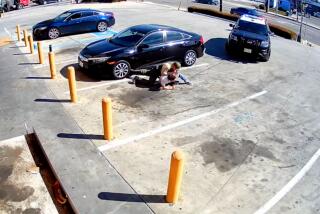Charges Are Dropped in Officer’s Slaying
- Share via
More than two years after he was accused of slaying a Garden Grove police officer, John J.C. Stephens walked out of Orange County Jail a free man Wednesday as prosecutors abruptly dropped murder charges against him.
The decision came two days after a judge dealt a severe blow to the prosecution’s fragile case by barring the testimony of a key witness who, the court ruled, had been coerced by police into making incriminating statements against Stephens.
Left with no eyewitnesses, forensic evidence or a murder weapon connecting Stephens to the 1993 murder of Officer Howard E. Dallies Jr., prosecutors said they could not prove their case in court.
Stephens, 28, walked out of jail at about 4 p.m., smiling and shrugging off reporters’ questions. Family and friends surrounded him as he got into a car that sped away from the detention facility.
Dallies’ murder while he was on routine overnight patrol six years ago stunned the county and began a mystery that now may never be conclusively solved.
Although the district attorney’s office said it will continue to investigate the murder, officials said it is unlikely that any charges will be filed unless they uncover significant new evidence.
Already the most expensive and complex investigation in Garden Grove police history, the case has created friction between prosecutors and police and raised questions about the tactics employed by detectives.
The district attorney’s office had decided two weeks ago to drop the case before the preliminary hearing but reversed course at the last minute after intense lobbying by Garden Grove police.
“Stephens may well have killed Officer Dallies . . . but it cannot be proven in a court of law,” said Deputy Dist. Atty. Rick King.
Stephens’ attorney, however, accused police of building a severely flawed case built largely on false statements from witnesses who are not credible.
“The tragedy remains that the intimidation, coercion and pressure tactics used by [police] . . . resulted in the production of lies,” said associate public defender Stephen J. Biskar.
For Stephens’ supporters, the decision to drop charges offered vindication. “It’s a big relief,” said a friend, Ruthie Wickwar. “I knew he didn’t do it.’
But Dallies’ colleagues, especially those officers who spent years searching for the killer, expressed anger and disbelief at the turn of events.
“Obviously, myself and members of both task forces are devastated,” said Sgt. Michael Handfield. “We worked the information the best we could.”
The investigation of Dallies’ slaying was fraught with difficulties from the start. Detectives had little to go on as they tried desperately to unravel the case, other than a witness who saw a motorcycle race from the scene and the 36-year-old officer’s dying words that described his killer: “White, male, young.”
In the years that followed, a team of more than 40 investigators chased down about 3,000 leads. But detectives were unable to unearth the .38-caliber handgun used in the killing and linked to the shooting of a Santa Ana security guard, Rene Carpio. Police never found forensic evidence or any witnesses who could positively identify Stephens as Dallies’ killer.
Instead, investigators constructed a case based on circumstantial evidence, most of it from drug users and bikers who knew Stephens.
Police focused on Stephens after ballistics tests matched the weapon fired at Dallies with the one used to severely wound Carpio two months earlier. Stephens’ name popped up repeatedly when investigators released a sketch of the security guard’s assailant.
At first, Stephens’ alibi looked solid. His girlfriend, Delores “Lola” Duvall, said he had been with her the night of the killing. But under police interrogation, she recanted, telling detectives that Stephens came home a few hours after the shooting, told her that he had been involved and then dyed his hair.
Others also buckled during police interviews, providing statements that implicated Stephens. In July 1997, more than four years after Dallies was gunned down, police arrested Stephens.
But the case began to collapse Monday, when Superior Court Judge John J. Ryan raised serious questions about police tactics. The judge ruled that detectives had coerced Patricia McFarland--who has cerebral palsy and is dyslexic--into giving them a statement implicating Stephens as the killer.
McFarland twice told detectives--and twice recanted during further interviews--that she was at Duvall’s home when Stephens returned home a few hours after Dallies was killed, talking about a shooting. She said Stephens then dyed his hair.
But she insisted under oath last week that she had fabricated the tale because she had felt frightened by police. Ryan agreed.
Defense attorneys said that detectives had engaged in a pattern of coercion during interviews of possible witnesses, many of whom were drug addicts, parolees or probationers.
More to Read
Sign up for Essential California
The most important California stories and recommendations in your inbox every morning.
You may occasionally receive promotional content from the Los Angeles Times.












